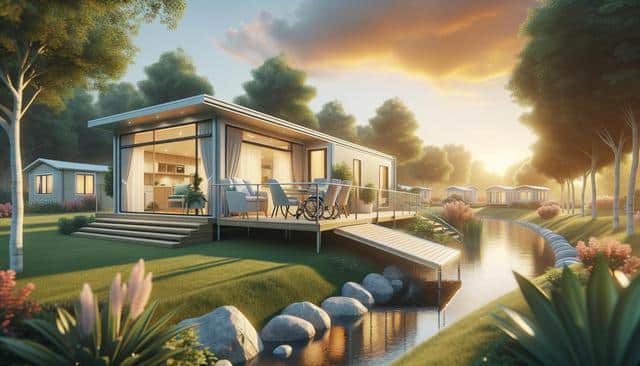
Embracing the Nomadic Lifestyle: A Guide to Mobile Retirement Homes
Why Mobile Retirement Homes Are Gaining Popularity
Retirement often marks the beginning of a new chapter, and for many, it’s the perfect time to embrace a more adventurous lifestyle. Mobile retirement homes are becoming an increasingly attractive option for retirees who want flexibility, freedom, and the opportunity to explore. Unlike traditional retirement communities, mobile homes allow individuals to travel without sacrificing the comforts of home. This lifestyle caters to those who value experiences over possessions and are eager to see more of the world—or at least the country—at their own pace.
Several factors contribute to the growing interest in mobile retirement living:
- Rising cost of stationary housing in many retirement destinations
- Desire for a minimalist, clutter-free lifestyle
- Access to nature and new environments
- Sense of independence and control over daily routines
These homes often come equipped with modern amenities such as full kitchens, comfortable sleeping arrangements, and even home office setups, making them well-suited for long-term living. For retirees who enjoy a nomadic lifestyle, mobile retirement homes offer a balance between comfort and mobility.
The Practical Side of Mobile Living
Transitioning to a mobile retirement home involves more than just buying a vehicle and hitting the road. There are several practical considerations that need to be addressed to make the experience enjoyable and sustainable. First and foremost is choosing the right type of mobile home—whether it’s a motorhome, camper van, or towable trailer. Each option has its pros and cons depending on budget, travel frequency, and desired amenities.
Other important considerations include:
- Licensing and insurance requirements
- Budgeting for fuel, maintenance, and campground fees
- Accessibility features for aging in place
- Reliable internet and phone connectivity
Planning ahead can make the transition smoother and more enjoyable. Many retirees choose to downsize significantly before moving into a mobile home, which often involves selling or storing household items. This process can be liberating for those ready to embrace a simpler, more intentional way of living.
Community on the Move
One of the common misconceptions about mobile retirement living is that it can be isolating. In reality, many retirees find a strong sense of community among fellow travelers. There are numerous social opportunities, from organized meetups and rallies to casual interactions at RV parks and campgrounds. These communities foster a sense of belonging and mutual support, which can be especially beneficial for solo travelers or couples seeking new friendships.
Mobile living communities often share tips on:
- Route planning and scenic destinations
- Maintenance advice and DIY solutions
- Cooking and meal prep in compact spaces
- Staying safe while on the road
Thanks to online forums and social media groups, it’s easier than ever to connect with like-minded retirees who share a passion for travel. This sense of camaraderie can enhance the mobile lifestyle and provide reassurance for those just starting out.
Designing a Comfortable Mobile Home
Comfort is key when it comes to long-term living in a mobile retirement home. Fortunately, today’s mobile home designs offer a range of customizable features to meet various needs and preferences. From ergonomic furniture to energy-efficient appliances, the goal is to create a space that feels like home—no matter where the road leads.
Popular features among retirees include:
- Adjustable beds and seating for improved comfort
- Compact but fully functional kitchens
- Solar panels and battery systems for off-grid capabilities
- Ample storage with smart organization solutions
For those with mobility challenges, there are models designed with wider doorways, grab bars, and low-step entrances. Investing in a layout that prioritizes both function and comfort can make a significant difference in daily living and overall satisfaction.
Planning for the Long Haul
While the freedom of the open road is enticing, it’s important to plan for the long term. Retirees should consider how they will handle healthcare needs, access to medications, and routine check-ups while on the move. Fortunately, many mobile retirees build their travel schedules around access to healthcare providers or return periodically to a home base.
Other long-term considerations include:
- Establishing a legal domicile for tax and voting purposes
- Staying compliant with insurance and registration laws across states
- Maintaining a flexible yet stable income stream (e.g., pensions, savings)
- Preparing for unexpected repairs or emergencies
With proper planning and a flexible mindset, many retirees find that mobile retirement living is not only sustainable but also incredibly fulfilling. It offers the chance to live with fewer constraints and more opportunities for discovery, all while maintaining a sense of familiarity through a well-designed home on wheels.
Conclusion: A Lifestyle of Freedom and Fulfillment
Mobile retirement homes represent a unique blend of adventure, comfort, and practicality. For retirees who crave new experiences and value autonomy, this lifestyle offers a compelling alternative to traditional retirement living. Whether exploring national parks, visiting family across the country, or simply enjoying the journey, mobile homes provide the flexibility to make the most of retirement years. With thoughtful planning and a spirit of exploration, retirees can embrace a lifestyle that’s not only mobile but deeply rewarding.